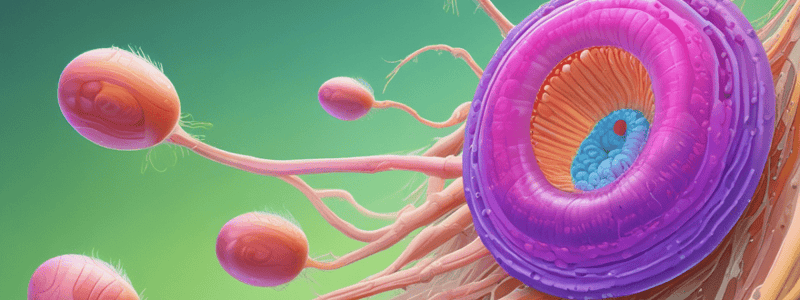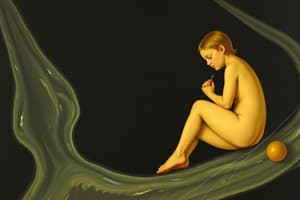Podcast
Questions and Answers
When does ______ happen in sea urchins? - once meiosis is completed
When does ______ happen in sea urchins? - once meiosis is completed
fertilization
Response of sperm to fertilization - acrosomal ______
Response of sperm to fertilization - acrosomal ______
reaction
Responses of egg to fertilization 1) Slow polyspermy block - Sea Urchin egg - Madako egg 2) Fast polyspermy block - Sea Urchin egg - Madako egg Diagram of seas urchin sperm Plasma membrane - first barrier of ______
Responses of egg to fertilization 1) Slow polyspermy block - Sea Urchin egg - Madako egg 2) Fast polyspermy block - Sea Urchin egg - Madako egg Diagram of seas urchin sperm Plasma membrane - first barrier of ______
protection
Mitochondria - energy generated for power and speed of sperm; ______
Mitochondria - energy generated for power and speed of sperm; ______
Nucleus - 'driver' of sperm; takes up most of the cell space (since the whole purpose of the sperm is to carry ______)
Nucleus - 'driver' of sperm; takes up most of the cell space (since the whole purpose of the sperm is to carry ______)
G-actin - aka globular actin - The individual actin molecules which have polarity which gives overall polarity to the actin filament (F-actin) - monomers of F-actin - oriented in a way that the F-actin has a distinct plus end and a minus end - Stored underneath the acrosomal vesicle in its unpolymerized stage (has not formed F-actin yet) F-actin - A fibrous protein made of a long chain of G actin molecules twisted into a helix - has distinct positive and negative ______
G-actin - aka globular actin - The individual actin molecules which have polarity which gives overall polarity to the actin filament (F-actin) - monomers of F-actin - oriented in a way that the F-actin has a distinct plus end and a minus end - Stored underneath the acrosomal vesicle in its unpolymerized stage (has not formed F-actin yet) F-actin - A fibrous protein made of a long chain of G actin molecules twisted into a helix - has distinct positive and negative ______
What happens when the sperm makes initial contact with the egg? - ______
What happens when the sperm makes initial contact with the egg? - ______
N. Hartsoeker created an early version of the microscope in ______
N. Hartsoeker created an early version of the microscope in ______
The first spermists' theory developed by N. Hartsoeker proposed a microscopic-sized human inside each sperm called a ______
The first spermists' theory developed by N. Hartsoeker proposed a microscopic-sized human inside each sperm called a ______
Model systems used to examine animal development include Medaka egg, Sea urchin, ______, and ______
Model systems used to examine animal development include Medaka egg, Sea urchin, ______, and ______
The frog life cycle begins with egg and sperm forming a ______ through fertilization
The frog life cycle begins with egg and sperm forming a ______ through fertilization
Cells divide through a process called ______
Cells divide through a process called ______
Gastrulation leads to the formation of three distinct cell layers in a structure called ______
Gastrulation leads to the formation of three distinct cell layers in a structure called ______
In ______, organs reach a state of maturity where they can start to function
In ______, organs reach a state of maturity where they can start to function
There is a rapid increase in ______ Ca2+ following the fusion of the sperm membrane with the egg's membrane.
There is a rapid increase in ______ Ca2+ following the fusion of the sperm membrane with the egg's membrane.
If cytosolic Ca2+ is increased by other means, in the absence of ______, many of the events of normal fertilization are initiated.
If cytosolic Ca2+ is increased by other means, in the absence of ______, many of the events of normal fertilization are initiated.
Evidence for calcium levels after fertilization comes from the paper "a free ______ wave traverses the activating egg of the medaka [Japanese rice fish]".
Evidence for calcium levels after fertilization comes from the paper "a free ______ wave traverses the activating egg of the medaka [Japanese rice fish]".
Geroge T. Reynold from ______ measured calcium levels shortly after fertilization occurs.
Geroge T. Reynold from ______ measured calcium levels shortly after fertilization occurs.
Reynold found that a wave of Ca2+ sweeps across the fertilized egg of ______, frogs, and sea urchins.
Reynold found that a wave of Ca2+ sweeps across the fertilized egg of ______, frogs, and sea urchins.
A rise in Ca2+ occurs in all ______ at fertilization.
A rise in Ca2+ occurs in all ______ at fertilization.
An increase of Ca2+ is a ______ for development, but it will eventually cease since you need the DNA from the sperm to continue this process.
An increase of Ca2+ is a ______ for development, but it will eventually cease since you need the DNA from the sperm to continue this process.
Ernest Everett studied sea urchin fertilization at the Marine Biological Lab in Woods Hole, MA - described the event that took place when a sea urchin egg is exposed to ______
Ernest Everett studied sea urchin fertilization at the Marine Biological Lab in Woods Hole, MA - described the event that took place when a sea urchin egg is exposed to ______
In 2, you can see that most of the sperm have disappeared and there is only the one predominant ______
In 2, you can see that most of the sperm have disappeared and there is only the one predominant ______
There is a raised line in close association to where the sperm is ______
There is a raised line in close association to where the sperm is ______
In 5 and 6, you begin to see a rather large space forming where the sperm made contact that continues to get wider and wider till in 9 it's made its way all the way around the egg [turned out to be ______
In 5 and 6, you begin to see a rather large space forming where the sperm made contact that continues to get wider and wider till in 9 it's made its way all the way around the egg [turned out to be ______
As microscope techniques improved, we began to more clearly view what was happening with cortical vesicles (CV) - aka cortical granule - Several large vesicles directly underneath the plasma membrane of the egg in sea ______
As microscope techniques improved, we began to more clearly view what was happening with cortical vesicles (CV) - aka cortical granule - Several large vesicles directly underneath the plasma membrane of the egg in sea ______
When the sperm's plasma membrane fuses with the egg's plasma membrane, the cortical vesicle fuses with the egg's plasma membrane releasing its content (exocytosis) into the ______ space
When the sperm's plasma membrane fuses with the egg's plasma membrane, the cortical vesicle fuses with the egg's plasma membrane releasing its content (exocytosis) into the ______ space
Ernest Everett's pictures showed in 1 that the egg is surrounded by ______
Ernest Everett's pictures showed in 1 that the egg is surrounded by ______
This is what generates the force to push the membrane further from the ______ - aka slow block to polyspermy.
This is what generates the force to push the membrane further from the ______ - aka slow block to polyspermy.
After sperm fuses with the egg, its ______ and pronucleus (contains its DNA) are released into the egg.
After sperm fuses with the egg, its ______ and pronucleus (contains its DNA) are released into the egg.
The slow block to polyspermy is the formation of the ______ envelope and other changes in an egg's surface.
The slow block to polyspermy is the formation of the ______ envelope and other changes in an egg's surface.
The slow block begins about ______ minute after fertilization.
The slow block begins about ______ minute after fertilization.
Lord Rothschild measured the time needed for the ______ of polyspermy.
Lord Rothschild measured the time needed for the ______ of polyspermy.
Lord Rothschild found that there were two blocks: one that occurred in a couple ______, and one that took up to a minute.
Lord Rothschild found that there were two blocks: one that occurred in a couple ______, and one that took up to a minute.
Rindy Jaffe was a Purdue ______ in biology.
Rindy Jaffe was a Purdue ______ in biology.
Rindy Jaffe got her PhD under ______ at UCLA.
Rindy Jaffe got her PhD under ______ at UCLA.
Rindy Jaffe's paper on the fast block was part of her ______ thesis.
Rindy Jaffe's paper on the fast block was part of her ______ thesis.
Be familiar with the difference between the ______ and the fast blocks.
Be familiar with the difference between the ______ and the fast blocks.
Study Notes
Slow Block to Polyspermy
- The slow block begins about 1 minute after fertilization
- It involves the formation of the fertilization envelope and other changes in an egg's surface that prevent fusion of the egg with more than one sperm
Fast Block to Polyspermy
- Occurs within a few seconds of fertilization
- Discovered by Lord Rothschild
- Rindy Jaffe Experiment: a Purdue undergraduate's research on the fast block using sea urchins
Sperm Structure
- Plasma membrane: first barrier of protection
- Mitochondria: energy generated for power and speed of sperm; "motor"
- Tail: controls movement
- Nucleus: "driver" of sperm; takes up most of the cell space
- Acrosomal vesicle: head of sperm; first part of sperm to interact with egg
- G-actin: individual actin molecules with polarity, stored underneath the acrosomal membrane
Process of Fertilization
- Initial contact: sperm's acrosomal vesicle releases enzymes to penetrate the egg
- Fusion of sperm's plasma membrane with the egg's plasma membrane triggers a rise in cytosolic Ca2+
- Calcium wave traverses the activating egg, triggering development
Egg Response to Fertilization
- Slow polyspermy block: formation of the fertilization envelope and changes in the egg's surface
- Fast polyspermy block: rapid changes in the egg's surface to prevent polyspermy
- Cortical vesicles: large vesicles underneath the plasma membrane; release contents into the perivitelline space upon fertilization
Developmental Biology
- Model systems: Medaka egg, Sea urchin, Frog, Chick
- Hartsoeker's microscopy: examined sperm under a microscope, developed the pre-formist theory
- Frog life cycle: fertilization, cleavage, blastula, gastrulation, organogenesis, histogenesis, hatching, postembryonic development
Studying That Suits You
Use AI to generate personalized quizzes and flashcards to suit your learning preferences.
Related Documents
Description
Test your knowledge on the processes of spermatogenesis and oogenesis, understanding the beginning components and endpoints. Learn about N. Hartsoeker, the scientist who created an early version of the microscope to study early stages of development, and his theory of Homunculus in sperm.




